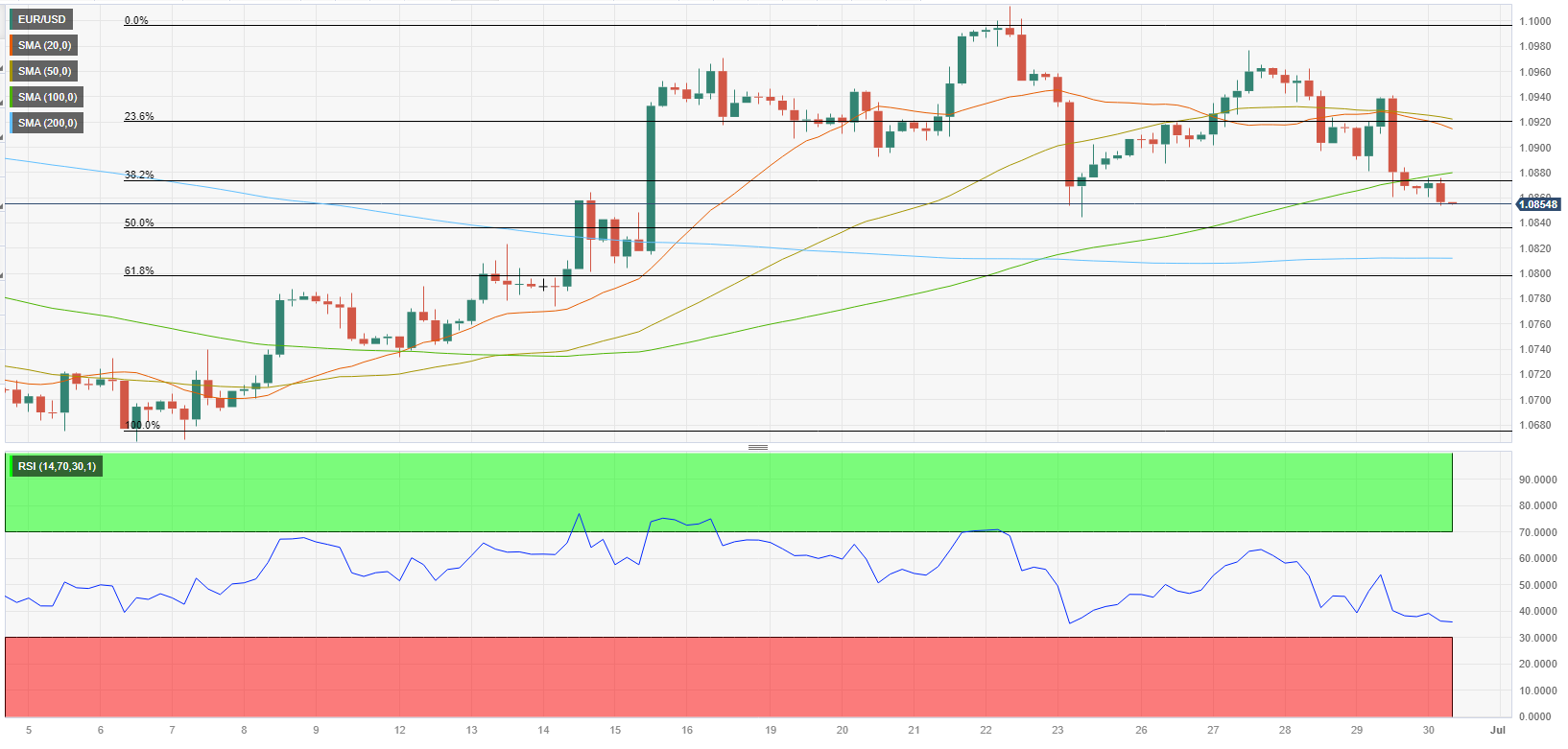- EUR/USD consolidates losses below 1.0900 following Thursday's drop.
- Inflation data from the EU and the US will be watched closely by market participants.
- Quarter-end flows could ramp up market volatility later in the day.
EUR/USD suffered large losses on Thursday as the US Dollar continued to gather strength against its rivals on robust macroeconomic data releases. The pair trades below 1.0900 early Friday as investors stay on the sidelines while waiting for key inflation data.
The Core Harmonized Index of Consumer Prices (HICP) in the Eurozone is forecast to rise 0.7% in June, up sharply from the 0.2% increase recorded in May. Following the hot inflation figures from Spain and Germany earlier this week, a strong HICP growth in the Eurozone shouldn't be surprising. Hence, the Euro could continue to weaken on a smaller-than-forecast increase but could find it difficult to rebound unless there is a significant upside surprise in the monthly Core HICP.
In the second half of the day, the Personal Consumption Expenditures (PCE) Price Index, the Fed's preferred gauge of inflation, will be featured in the US economic docket.
On Thursday, the annualized Gross Domestic Product (GDP) growth for the first quarter got revised higher to 2% from 1.3% in the US Bureau of Economic Analysis' previous estimate. Additionally, the number of first-time applications for unemployment benefits fell nearly 30,000.
As data from the US highlight the resilience of the economy, the Federal Reserve (Fed) could continue to stay focused on taming inflation. The CME Group FedWatch Tool shows that markets are currently pricing in a less than 40% probability of the Fed raising the policy rate by a total of 50 basis points in the remainder of the year. Hence, an increase of 0.5% or higher in the monthly Core PCE Price Index could attract hawkish Fed bets and provide a boost to the USD.
It's also worth mentioning that the market volatility could rise toward the end of the European session amid quarter-end flows. Inter-market correlations could weaken heading into the weekend, distorting the impact of the data releases on the pair.
EUR/USD Technical Analysis
EUR/USD stays below 1.0870, where the Fibonacci 23.6% retracement of the latest uptrend and the 100-period Simple Moving Average (SMA) on the 4-hour chart are located. Meanwhile, the Relative Strength Index (RSI) indicator on the same chart stays well below 50, reflecting the bearish bias.
1.0840 (Fibonacci 50% retracement) aligns as next support before 1.0815 (200-period SMA) and 1.0800 (psychological level, Fibonacci 61.8% retracement).
In case EUR/USD manages to stabilize above 1.0870, it could face next resistance at 1.0900 (psychological level) before 1.0920/30 (Fibonacci 23.6% retracement, 20-period SMA, 50-period SMA).
Information on these pages contains forward-looking statements that involve risks and uncertainties. Markets and instruments profiled on this page are for informational purposes only and should not in any way come across as a recommendation to buy or sell in these assets. You should do your own thorough research before making any investment decisions. FXStreet does not in any way guarantee that this information is free from mistakes, errors, or material misstatements. It also does not guarantee that this information is of a timely nature. Investing in Open Markets involves a great deal of risk, including the loss of all or a portion of your investment, as well as emotional distress. All risks, losses and costs associated with investing, including total loss of principal, are your responsibility. The views and opinions expressed in this article are those of the authors and do not necessarily reflect the official policy or position of FXStreet nor its advertisers. The author will not be held responsible for information that is found at the end of links posted on this page.
If not otherwise explicitly mentioned in the body of the article, at the time of writing, the author has no position in any stock mentioned in this article and no business relationship with any company mentioned. The author has not received compensation for writing this article, other than from FXStreet.
FXStreet and the author do not provide personalized recommendations. The author makes no representations as to the accuracy, completeness, or suitability of this information. FXStreet and the author will not be liable for any errors, omissions or any losses, injuries or damages arising from this information and its display or use. Errors and omissions excepted.
The author and FXStreet are not registered investment advisors and nothing in this article is intended to be investment advice.
Recommended Content
Editors’ Picks

EUR/USD stays below 1.0800 after upbeat US data
EUR/USD struggles to gain traction and trades below 1.0800 in the American session on Wednesday. Upbeat February Durable Goods Orders data from the US support the US Dollar in the second half of the day, making it difficult for the pair to stage a rebound.

GBP/USD drops to fresh two-week lows below 1.2900
GBP/USD remains under pressure and trades at a fresh two-week low below 1.2900 in the American session on Wednesday. Soft February inflation data from the UK and the Spring Budget delivered by Chancellor Rachel Reeves weigh on Pound Sterling midweek.

Gold clings to modest daily gains above $3,020
Gold fluctuates in a relatively tight range and manages to hold above $3,020 midweek. The precious metal seems to be benefiting from the positive sentiment surrounding the commodities after Copper climbed to a new all-time high earlier in the day.

Bitcoin holds $87,000 as markets brace for volatility ahead of April 2 tariff announcements
Bitcoin (BTC) holds above $87,000 on Wednesday after its mild recovery so far this week. A K33 Research report explains how the markets are relatively calm and shaping up for volatility as the market absorbs the tariff announcements.

Sticky UK services inflation shows signs of tax hike impact
There are tentative signs that the forthcoming rise in employer National Insurance is having an impact on service sector inflation, which came in a tad higher than expected in February. It should still fall back in the second quarter, though, keeping the Bank of England on track for three further rate cuts this year.

The Best brokers to trade EUR/USD
SPONSORED Discover the top brokers for trading EUR/USD in 2025. Our list features brokers with competitive spreads, fast execution, and powerful platforms. Whether you're a beginner or an expert, find the right partner to navigate the dynamic Forex market.
